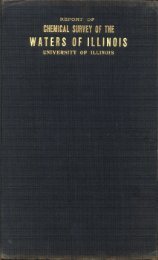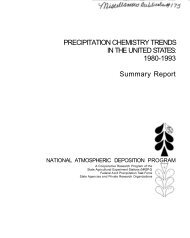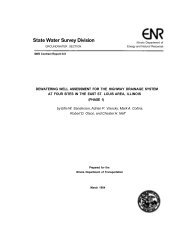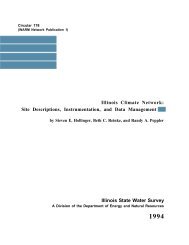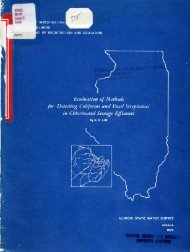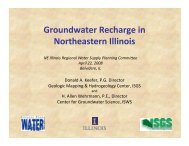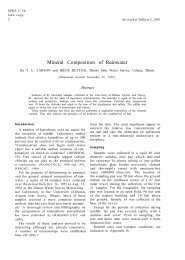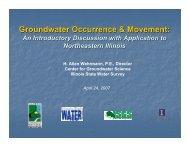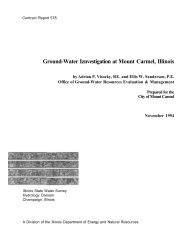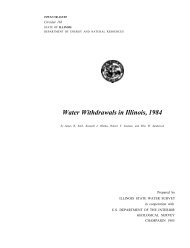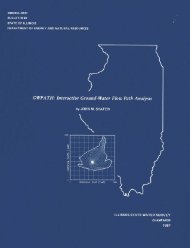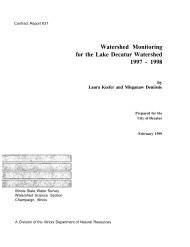Ground-water development in East St. Louis area, Illinois. Urbana, IL ...
Ground-water development in East St. Louis area, Illinois. Urbana, IL ...
Ground-water development in East St. Louis area, Illinois. Urbana, IL ...
You also want an ePaper? Increase the reach of your titles
YUMPU automatically turns print PDFs into web optimized ePapers that Google loves.
where:<br />
(16)<br />
(17)<br />
(18)<br />
The reach of the streambed, , with<strong>in</strong> the <strong>area</strong> of <strong>in</strong>fluence<br />
of pump<strong>in</strong>g is determ<strong>in</strong>ed by not<strong>in</strong>g the location<br />
of the po<strong>in</strong>ts upstream and downstream where drawdown<br />
is negligible (say 0.01). The <strong>area</strong> of <strong>in</strong>duced <strong>in</strong>filtration,<br />
A r , is then the product of L r and the average<br />
distance between the river's edge and the recharge<br />
boundary.<br />
The <strong>in</strong>filtration rate of the stream bed per unit <strong>area</strong><br />
can be computed with the follow<strong>in</strong>g equation:<br />
where:<br />
(19)<br />
Rough approximations of the average head loss, s r ,<br />
due to the vertical percolation of <strong>water</strong> through the<br />
stream bed can be determ<strong>in</strong>ed by averag<strong>in</strong>g drawdowns<br />
computed at many po<strong>in</strong>ts with<strong>in</strong> the <strong>area</strong> of <strong>in</strong>filtration.<br />
Values of drawdown with<strong>in</strong> the stream-bed <strong>area</strong> of <strong>in</strong>filtration<br />
are computed, tak<strong>in</strong>g <strong>in</strong>to consideration the<br />
pumped well and the image well associated with <strong>in</strong>duced<br />
<strong>in</strong>filtration, with equations 14 through 18.<br />
The average <strong>in</strong>filtration rate of the stream bed per<br />
unit <strong>area</strong> per foot of head loss can be estimated by use of<br />
the follow<strong>in</strong>g equation:<br />
where:<br />
(20)<br />
The <strong>in</strong>filtration rate of the Mississippi River bed at<br />
three sites was determ<strong>in</strong>ed from aquifer-test data. The<br />
sites are just south of the confluence of Wood River and<br />
Figure 55. Graph show<strong>in</strong>g the relationship between percent of<br />
pumped <strong>water</strong> be<strong>in</strong>g diverted from a stream and the factor 'f'<br />
the Mississippi River, west of Wood River, and west of<br />
Monsanto. A summary of the results of aquifer tests<br />
and computed <strong>in</strong>filtration rates are given <strong>in</strong> table 27. The<br />
<strong>in</strong>filtration rate near the confluence of Wood River and<br />
the Mississippi River at a river temperature of 33F was<br />
estimated to be 305,000 gpd/acre/ft; the <strong>in</strong>filtration rate<br />
west of the city of Wood River was estimated to be<br />
36,300 gpd/acre/ft; and the <strong>in</strong>filtration rate west of<br />
Monsanto at a river temperature of 83F was estimated<br />
to be 91,200 gpd/acre/ft.<br />
Infiltration rates per foot of head loss vary with the<br />
temperature of the river <strong>water</strong>. Average monthly <strong>in</strong>filtra-<br />
48



